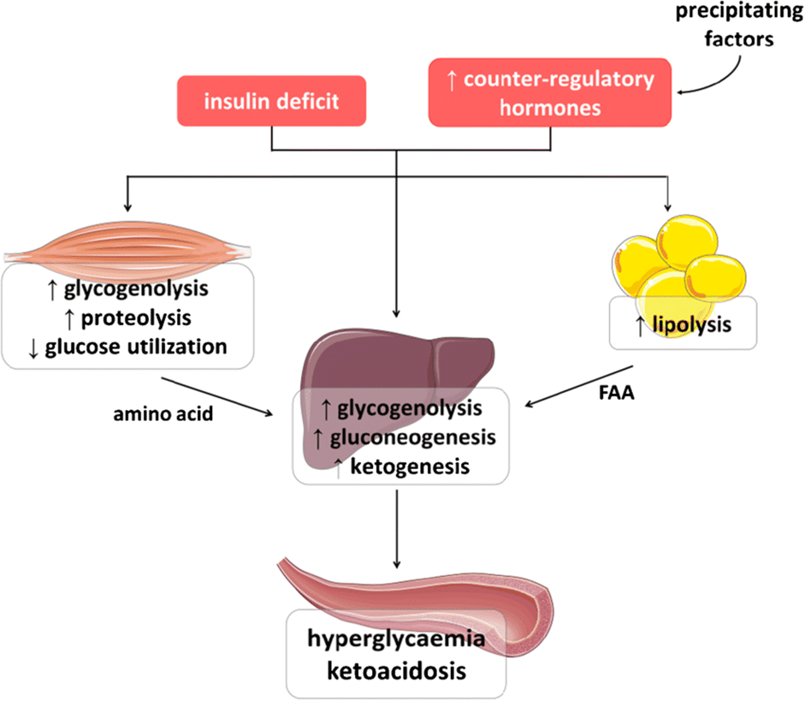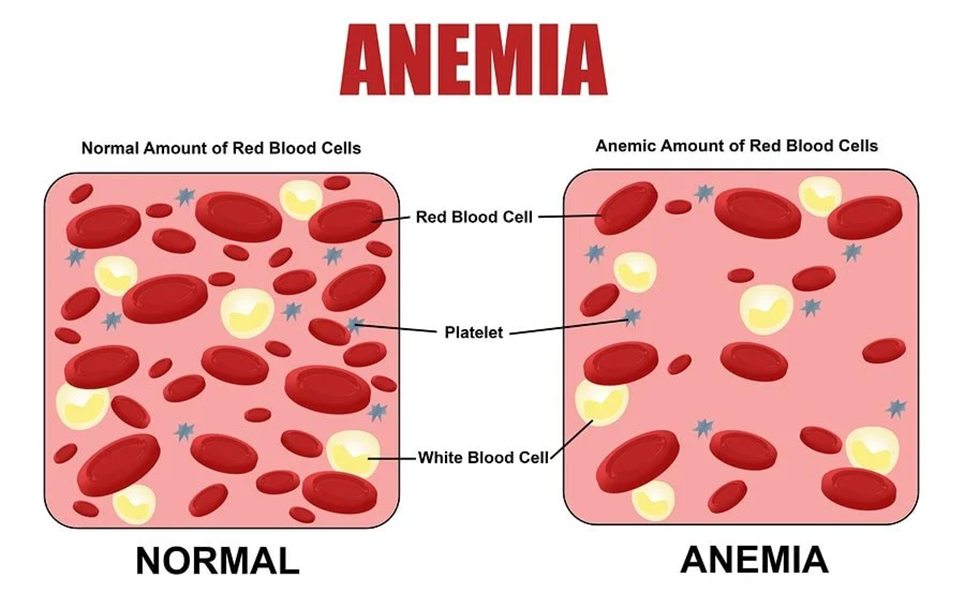The diabetic ketoacidosis associated with insulin deficiency is related to:
Extracellular hyperglycemia
Hypoglycemia
Use of fat and protein as an energy source
Increased cellular metabolism of glucose
The Correct Answer is C
Choice A reason:
Extracellular hyperglycemia refers to high blood sugar levels outside the cells. While hyperglycemia is a common feature of diabetic ketoacidosis (DKA), it is not the direct cause of the condition. DKA occurs when the body cannot use glucose for energy due to a lack of insulin, leading to the breakdown of fat and protein for energy, which produces ketones and causes acidosis.
Choice B Reason:
Hypoglycemia, or low blood sugar, is not associated with diabetic ketoacidosis. In fact, DKA is characterized by high blood sugar levels. Hypoglycemia is a separate condition that can occur in individuals with diabetes, particularly if they take too much insulin or skip meals.
Choice C Reason:
The use of fat and protein as an energy source is the primary mechanism behind diabetic ketoacidosis. When insulin is deficient, the body cannot utilize glucose for energy. As a result, it breaks down fat and protein to produce energy. This process generates ketones, which are acidic and lead to the development of ketoacidosis.

Choice D Reason:
Increased cellular metabolism of glucose is not related to diabetic ketoacidosis. In DKA, the problem is that cells cannot use glucose effectively due to a lack of insulin. Instead, the body resorts to breaking down fat and protein for energy, leading to the production of ketones and acidosis.
Nursing Test Bank
Naxlex Comprehensive Predictor Exams
Related Questions
Correct Answer is D
Explanation
Choice A reason:
Peanuts are not recommended for infants, especially those under one year of age, due to the risk of choking and potential allergies. Additionally, peanuts are not a significant source of iron and would not be effective in preventing iron deficiency anemia in infants. Therefore, this choice is not appropriate for preventing iron deficiency anemia in a 6-month-old infant.
Choice B reason:
Iron (ferrous sulfate) tablets are not typically recommended for infants unless prescribed by a healthcare provider. Infants who are exclusively breastfed or partially breastfed should receive iron supplementation starting at 4-6 months of age, but this is usually in the form of liquid drops rather than tablets. It is important to follow the guidance of a healthcare provider when administering iron supplements to infants.
Choice C reason:
Sautéed liver is a rich source of iron, but it is not suitable for a 6-month-old infant. Introducing solid foods to infants should be done gradually, starting with iron-fortified cereals and pureed fruits and vegetables. Liver can be introduced later as part of a balanced diet, but it is not the first choice for preventing iron deficiency anemia in a young infant.
Choice D reason:
Iron-fortified baby cereal is the recommended choice for preventing iron deficiency anemia in a 6-month-old infant who is still breastfeeding. These cereals are specifically designed to provide the necessary iron that infants need as they transition to solid foods. Starting with iron-fortified cereals helps ensure that the infant receives adequate iron to support healthy growth and development.

Correct Answer is C
Explanation
Choice A reason:
A diet consisting of low-fat, low-carbohydrate foods is not specifically recommended for managing severe edema associated with acute glomerulonephritis. While a balanced diet is important, the primary dietary focus should be on reducing sodium intake to prevent fluid retention and manage edema. Therefore, this choice is not the most appropriate recommendation.
Choice B reason:
Decreasing the number of calories in the child’s diet is not a primary recommendation for managing severe edema associated with acute glomerulonephritis. The focus should be on reducing sodium intake rather than calorie restriction. Adequate nutrition is essential for the child’s overall health and recovery1. Therefore, this choice is not the most appropriate recommendation.
Choice C reason:
Avoiding adding salt to the child’s food is a key recommendation for managing severe edema associated with acute glomerulonephritis. Sodium can lead to water retention, which can worsen edema and increase blood pressure. A low-sodium diet helps to reduce fluid retention and manage the symptoms of glomerulonephritis. This is the most appropriate dietary recommendation for managing severe edema in this condition.
Choice D reason:
Increasing the amount of protein in the child’s diet is not recommended for managing severe edema associated with acute glomerulonephritis1. In fact, protein intake may need to be monitored and possibly restricted to prevent the buildup of waste products in the blood1. The primary dietary focus should be on reducing sodium intake to manage edema. Therefore, this choice is not the most appropriate recommendation.
Whether you are a student looking to ace your exams or a practicing nurse seeking to enhance your expertise , our nursing education contents will empower you with the confidence and competence to make a difference in the lives of patients and become a respected leader in the healthcare field.
Visit Naxlex, invest in your future and unlock endless possibilities with our unparalleled nursing education contents today
Report Wrong Answer on the Current Question
Do you disagree with the answer? If yes, what is your expected answer? Explain.
Kindly be descriptive with the issue you are facing.
